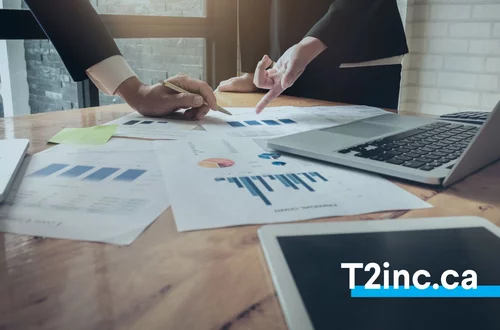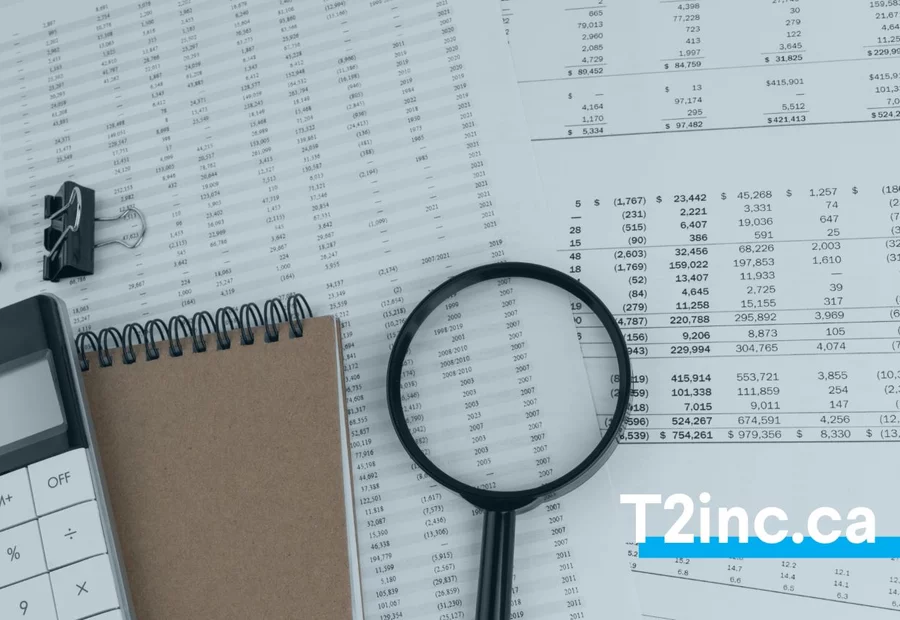Income statement for small business owners: explanation, example and template

The income statement is one of the three key financial statements used to assess a company’s financial health. It provides a clear overview of revenue and gains, expenses and losses, and helps determine the company’s profit or loss over a specific period of time (month, quarter, or year).
Whether you are a small business owner or run an incorporated company, understanding how to create an income statement will help you manage your business activities, analyze financial performance, and compare income statements across different periods.
In this article, our chartered professional accountants explain the purpose of an income statement, its key components, and provide an income statement template to help you prepare yours accurately.
What is an income statement?
An income statement, also known as a "profit and loss statement (P&L)" or "balance sheet", details a company’s revenue, cost of sales, and expenditure over a specific period. It helps business owners and investors determine if a company’s core operations are profitable.
In addition to showing the difference between operating revenues and expenses, the income statement can vary depending on the accounting software used and the activities performed. It can be prepared using two approaches, accrual accounting or cash accounting:
- Cash accounting, which records transactions only when there is an incoming or outgoing payment.
- Accrual accounting, which records revenues and expenses as they are incurred, independent of cash flows.
What is the primary purpose of an income statement?
The income statement is an essential document for any company, providing a clear and detailed view of its financial performance over a given period. It meets several strategic and accounting needs:
Fulfillment of tax obligations: Essential for filing of corporate tax returns. It is used to accurately calculate taxes payable and to ensure that information submitted to tax authorities, such as the Canada Revenue Agency and Revenu Québec, is accurate and compliant.
Obtain financing: Banks and investors use an income statement to assess earnings before interest and taxes (EBIT), financial stability, and repayment capacity before granting loans or financing.
Make strategic decisions: By identifying the main sources of revenue and expenses, the income statement helps managers adjust business strategies, optimize costs and improve profitability.
Compare year-over-year performance: The income statement provides insights into business growth by allowing owners to analyze income statements from different periods.
The difference between the balance sheet and the profit and loss statement
The income statement and the balance sheet are two complementary documents that play a key role in a company's financial statements. Although they are prepared at the end of the fiscal year, they serve different functions.
The balance sheet: a snapshot of financial health
The balance sheet represents the state of your company's finances at a given point in time. It shows what you own and what you owe to creditors. It includes:
- Assets: What the company owns (for example, cash, equipment, inventory).
- Liabilities: What the company owes (e.g., loans, vendor debt).
- Shareholders' equity: The company's net worth after subtracting liabilities from assets.
Income statement: a measure of profitability
Unlike the balance sheet, which is static, the income statement shows a company's financial performance over a period of time. It details:
- Income generated (sales, services).
- Expenses incurred (operating costs, salaries, depreciation).
- Net profit or loss after deducting expenses from revenues.
What are the main components of an income statement?
The income statement is used to analyze a company's profitability by subtracting expenses from revenues. To calculate it, it is necessary to collect a variety of financial data over a given period of time.
Here are the main components:
1. Operating income
Operating revenues, or sales, is the revenue generated from the sale of goods or services in the company's primary activity.
For example, if the company manufactures industrial equipment, its revenues will include only the manufacture of a product, not the sale of real estate. These secondary revenues are classified as non-operating revenues.
2. Cost of goods sold, cost of sales or cost of services
This section includes expenses directly related to the production or sale of products and services (these direct costs related to the production of a product vary from company to company). There are several categories:
- Cost of goods sold: used by manufacturing companies, it includes raw materials, labor, and depreciation of equipment.
- Cost of goods sold: used by retailers and wholesalers, it represents the acquisition cost of goods resold.
- Cost of services rendered: specific to service companies, it includes the costs incurred in providing the services offered.
These costs do not include administrative, marketing or financial expenses.
3. Gross profit
Gross profit is obtained by subtracting the cost of goods or services sold from operating income. It is calculated as follows:
👉 Formula: Gross profit = Sales - Cost of goods or services sold.
This result is also used to determine gross margin, which measures the profitability of sales before other expenses are taken into account:
👉 Formula: Gross margin (%) = (Gross profit ÷ Sales) × 100
4. Operating expenses
Operating expenses, also known as general and administrative expenses (G&A), include all indirect costs associated with running the business. These costs may include:
- Rent and utilities (electricity, heat, insurance)
- Marketing and advertising expenses
- Administrative salaries and benefits
- Professional fees (accounting, legal)
- Office supplies and computer costs
- Etc.
5. Operating income before other expenses
Operating profit is calculated by deducting operating expenses from gross profit. It represents the profitability of the main activity before taking into account financial and extraordinary expenses.
👉 Formula: Operating profit = Gross profit - Operating expenses
6. Other non-operating expenses
Other expenses represent gains and losses from non-core activities. Here are some examples:
- Interest on financial assets
- Dividends received
- Gains or losses from the sale of assets
- Exceptional charges, such as restructuring costs
7. Earnings before tax (EBT)
Profit before tax reflects the overall performance of the company before taking into account tax charges. It is calculated as follows:
👉 Formula: EBT = Operating income + Non-operating income - Non-operating expenses.
EBT is often used to compare the profitability of different companies because it excludes jurisdictional differences in taxation.
8. Net income
Net income, also known as net profit, is the final result on the income statement after deducting taxes. It represents the profit or loss realized by the company after all expenses.
👉 Formula: Net income = EBT - Income Taxes
This result is often used to calculate performance indicators such as:
- Net profit margin: a key indicator to compare profitability with other companies in the same industry.
- EBITDA (Earnings Before Interest, Taxes, Depreciation and Amortization): a measure used to analyze operating performance before financial and tax expenses.
Avoid errors on your income statement
Example: how to create an income statement
Let's take a concrete example to illustrate the structure of an income statement. Suppose the company Répare-Tout au Québec Inc. presents its income statement for the period January 1, 2024 to December 31, 2024.
This model allows business owners to understand how the various components of the income statement affect their company's profitability. It also allows them to identify the expense items they need to optimize in order to improve their profit margins.
| Item | Amount ($) |
|---|---|
| Operating income | 500 000 |
| Cost of goods/services sold | (200 000) |
| Gross profit | 300 000 |
| Operating expenses | |
| - Rent and utilities | (30 000) |
| - Marketing and advertising | (20 000) |
| - Salaries and benefits | (80 000) |
| - Accounting and legal fees | (10 000) |
| - Supplies and maintenance | (5 000) |
| Total operating expenses | (145 000) |
| Operating income | 155 000 |
| Other income and expenses | |
| - Interest income | 5 000 |
| - Losses on disposal of assets | (3 000) |
| Earnings before tax (EBT) | 157 000 |
| Income tax | (42 000) |
| Net income | 115 000 |
Interpretation of results
1. Operating income: The company generated $500,000 in sales from its core activities.
2. Cost of goods sold: The direct costs of production are $200,000, leaving a gross profit of $300,000.
3. Operating expenses: expenses related to running the business are $145,000, reducing operating profit to $155,000.
4. Other Income and Expenses: The company records $5,000 in interest income and a $3,000 loss on the sale of an asset.
5. Earnings before tax (EBT): After taking into account secondary income and losses, EBT is $157,000.
6. Taxes: The company must pay $42,000 in income taxes.
7. Net profit: After taxes, the company has a net profit of $115,000 for the year.
Income statement example for small business owners
REVENUES :
Revenues : __________
EXPENSES :
Direct costs :
- Salaries and commissions __________
- Depreciation costs __________
- Raw materials __________
Indirect costs :
- Operating expenses __________
- Selling expenses __________
- Administrative expenses __________
Other costs :
- Interest __________
- Moving expenses __________
TOTAL EXPENSES:__________
NET PROFIT / NET LOSS: __________
Get more business accounting tips from T2inc.ca
In summary, the income statement is an essential document in business accounting. It allows owners to gain a better understanding of their company's financial health and develop new strategic plans accordingly.
At T2inc.ca, we know these documents inside and out. They're essential for filing your T2 return, or CO-17 return in Quebec. Therefore, the information must be carefully compiled to avoid errors or delay filing your corporate income tax return.
Would you like more advice on how to structure your financial statements? Our tax professionals can help you optimize your returns. Get your free estimate today!
- What is an income statement?
- What is the primary purpose of an income statement?
- The difference between the balance sheet and the profit and loss statement
- What are the main components of an income statement?
- Avoid errors on your income statement
- Example: how to create an income statement
- Income statement example for small business owners
- Get more business accounting tips from T2inc.ca
Contact our experts
Have a question? Need help? Fill out our online form to get help from our experts.
Contact usNeed more help?
Contact us by filling out our form
Are you interested in our services, but would like more information before taking the plunge? Contact us today and one of our tax accountants will be in touch to help you.
At T2inc.ca, we're committed to helping business owners manage their company's tax affairs so they can grow their business.



